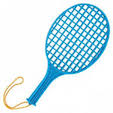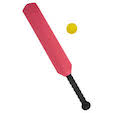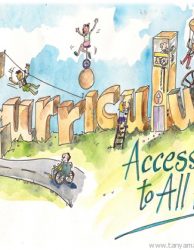Differentiation is a difficult concept for many physical educators to get their heads around. If you run a one-size-fits-all, teach to the ‘normal’, all-in activity, you will probably find in a class of 20 that: For about five students its too easy and a tad boring (unless they dominate everyone else); for 10 students its meeting needs at a point of optimal challenge and; for another five or so its chaos and completely disengaging. So what to do. There are many ways of course to avoid this situation, including some very easy practices such as using small cooperative group activities/games, where individuals generally have to be engaged to get the task done. You can use an approach to planning like Universal Design for Learning. This basically says there is no such thing as normal or average. Instead, you need to plan for the edges of your jagged learner profiles. You could read up on Mosston’s slanted rope inclusion style, I love that. Here is another way you can think about it. I call it the 3 Bears approach.
You all know the story of Goldilocks and the 3 Bears. Let’s assume that whilst the porridge was originally too hot for all of them causing them to go for a walk, Pappa Bear liked hot porridge, Baby Bear liked warm porridge and Momma Bear liked her porridge cold. It doesn’t really matter who liked what kind of porridge, the fact is they all liked porridge and all ate porridge but none of the porridge was the same. This scenario repeats itself for choices of a chair, bedding and various other things. They all sit, but they sit most comfortably when they sit on ‘their’ chair, which is different from the other two chairs. They all sleep, but they sleep best on their own particular mattress. You get the idea.
So, if you are planning a PE class, think of planning for the 3 Bears and any random Goldilocks people who rock up. You want them all to be doing the same activity (ie. eat porridge, sit down, sleep or play tee ball) but all doing it in a way that ‘works best’ for them. That is, their ‘best way’ to do the activity.
EXAMPLE: A striking game (small sided of course), depending on self-rated experience and chosen level of optimal challenge you can try one or more combinations of the following: Three types of bats; three types of pitches (Fast, medium, gentle or); three types of fielder set up (spread, 1/2 on one side, clustered). Just manipulate the constraints of the task, equipment or environment and let the students choose. “Oh but the talented students will pick the easiest option” I hear you say. Generally not. People like to be challenged. If they are underselling it, it is your job to give them a nudge. This is also a cool way to assess. If your assessment focuses on learning and growth, then they can demonstrate this by how far they move along the challenge continuum over time, irrespective of where they started from. If they want more or less challenge, let them adjust it but they need to account for their decisions.
In the one mixed ability small-sided game, students can nominate their choice of bat, pitch and maybe even field, based upon where they are optimally challenged. They don’t get judged because in your class difference is celebrated and you have taught them to acknowledge we have all had different opportunities and to respect (even celebrate) difference. In three classes from now, you will be looking for them to change it up after some effort and practice.
Now think about how your 3 Bears might want to play volleyball? Which one would have the net up full, which down low? Who would want to use the official volleyball that stings your arms? Is it best for Baby Bear to serve it from behind a line miles away just like Pappa Bear? You get the idea. Two options: a) Set up three different courts and let the students choose. b) Within mixed ability groups, allow choice (note its pretty hard to adjust the net up and down each time though).
I call this the rule of three* in another blog post
* The rule of 3: As a side note, it’s interesting how the rule of three works. Three little pigs, three Musketeers, three blind mice. While you won’t get everyone fitting neatly into three boxes, three is better than one and when you combine it with other options it becomes quite varied. The reason I think the rule of three works here is similar to why it works in storytelling. Three things bring enough variation to the table to satisfy and engage, the user is more likely to remember the choices and there is a rhythm to it. It also works for landscape gardening and photography I believe.




















